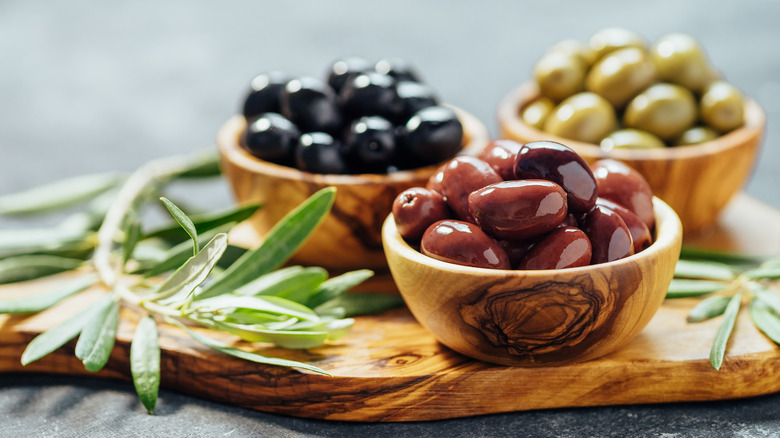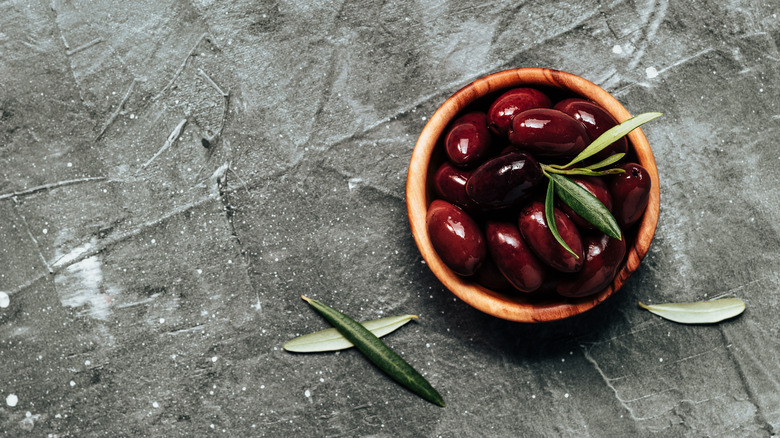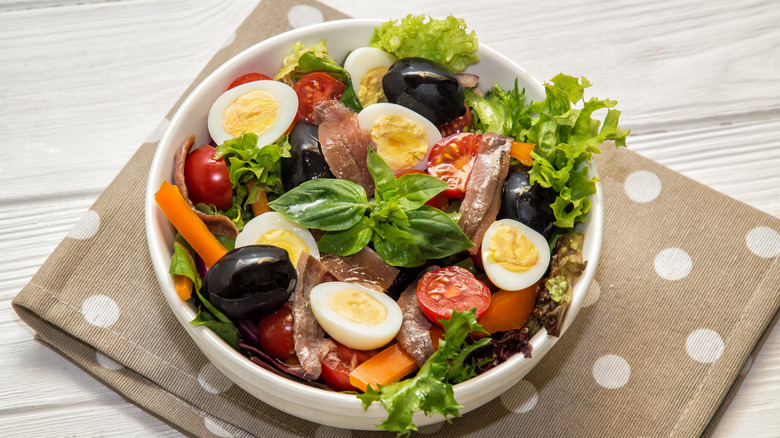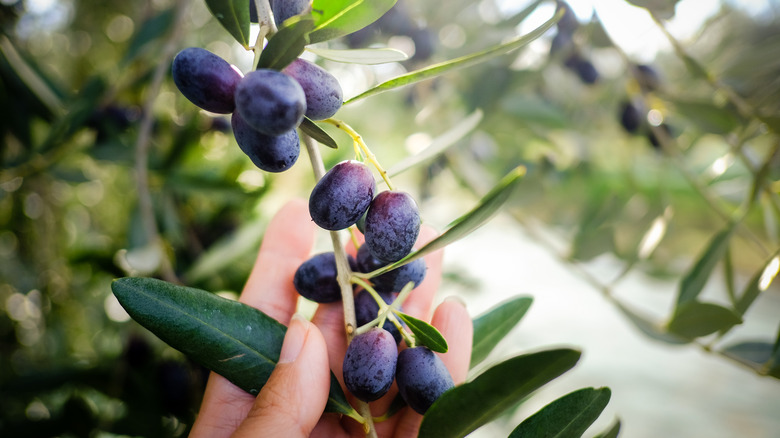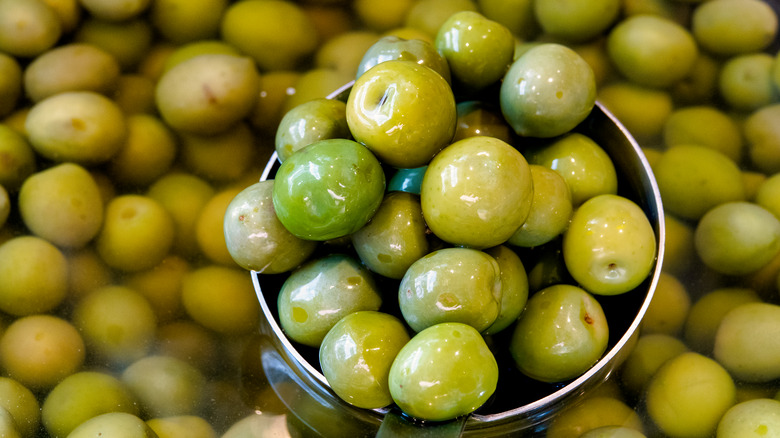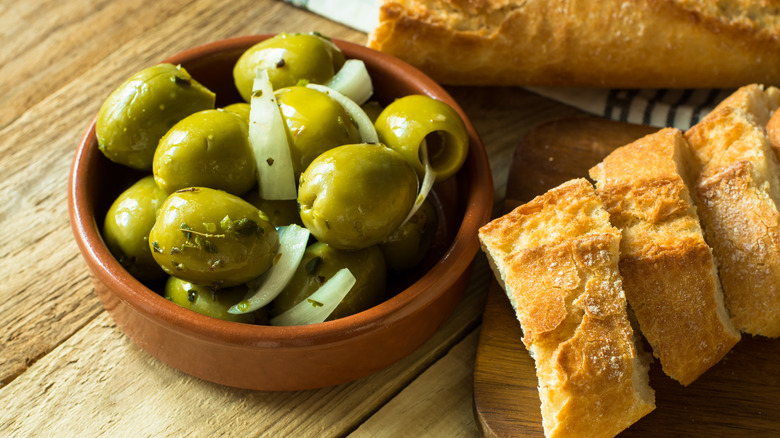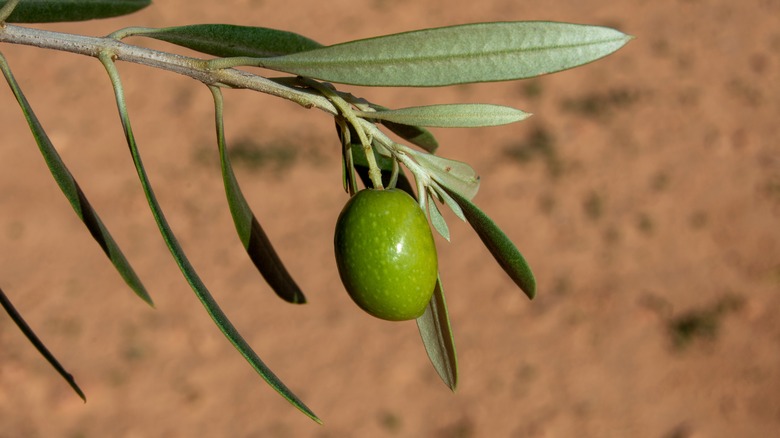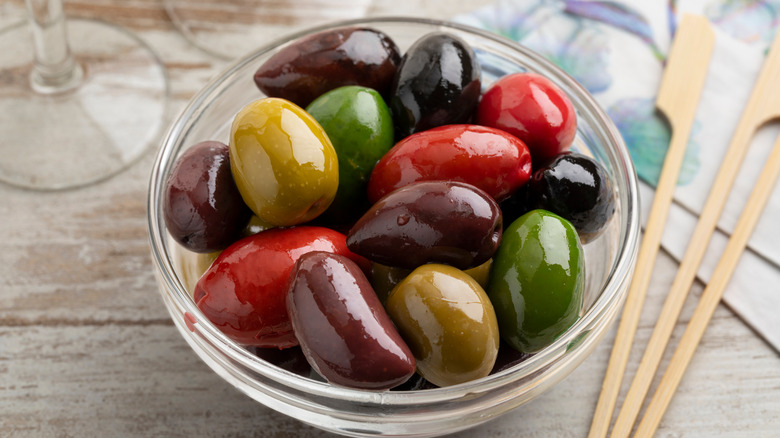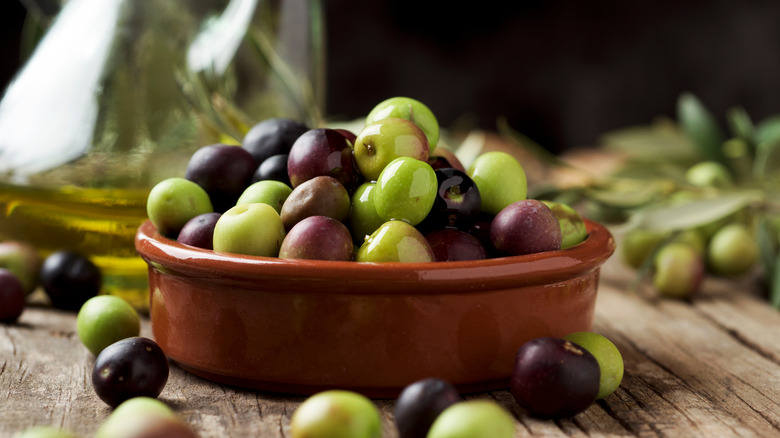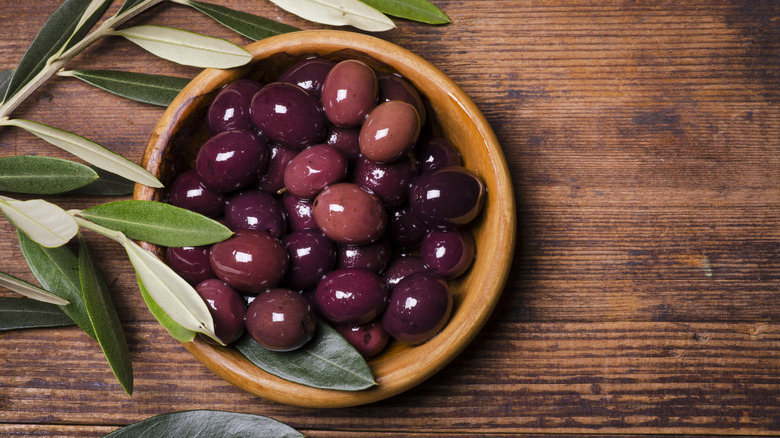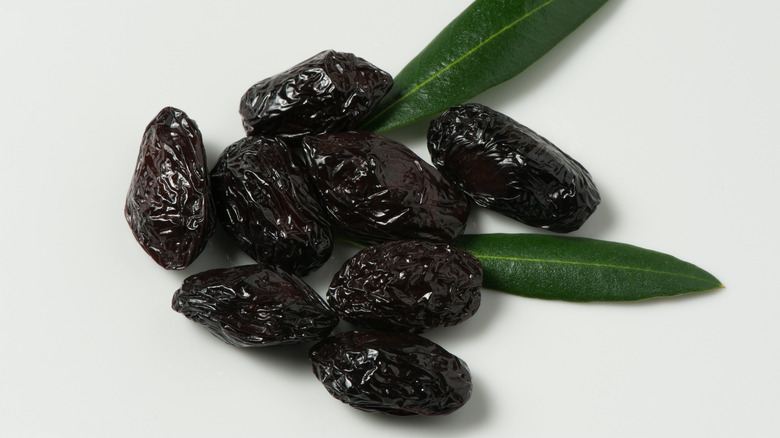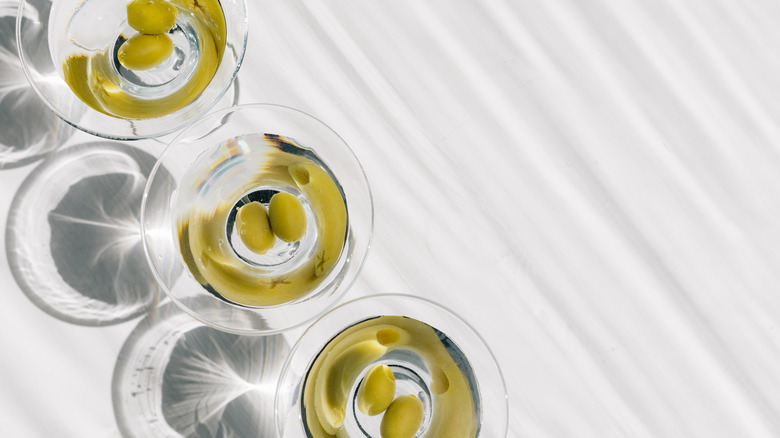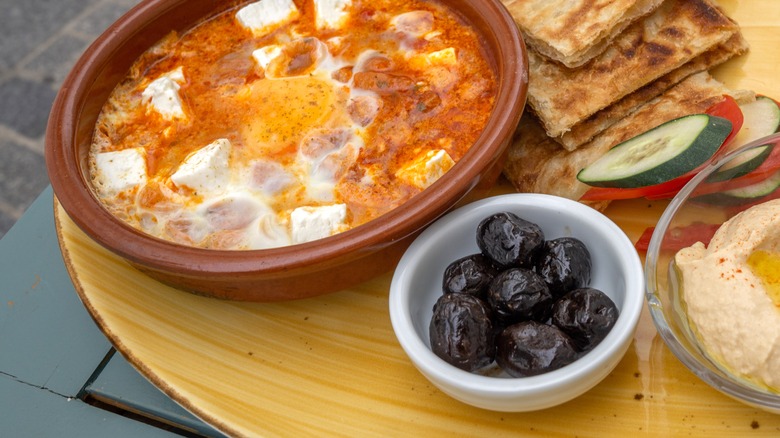13 Types Of Olives And What They're Used For
There's really no better way to describe olives than with one word: amazing. These fruits may be small, but they're packed with all kinds of goodness. Adding olives to dishes brings with it a whole different dimension of flavor, with many of the most popular varieties adding a delicious tingle of salt.
It gets even better when you start to look at all the health benefits that olives also bring to the table. Olives come with a healthy helping of good fats, per Healthline. They also have some impressive antioxidant properties and have been linked with improving overall heart health by helping to regulate cholesterol levels. Then, there's also the chance they'll help fight off osteoporosis can potentially prevent certain types of cancers. They're a total win!
According to Live Science, people have been enjoying olives for around 6,000 to 8,000 years, during which they've developed more than a thousand different varieities. Most come from the Mediterranean, although the Olive Oil Times says they're grown all over the world now. While there are definitely some you're more likely to find at the grocery store, don't let that limit you. And nope, "black" and "green" olives don't define varieties at all. In fact, all olives are green to begin with, turning black as they ripen! So, what are the differences between the most popular varieties? Let's talk olives.
Kalamata
Kalamata olives are perhaps one of the most common varieties out there. You might get them on your pizza and in other Italian dishes, for one, and they're great for cheese boards and snack platters. Before they get there, though, these little olives have to go through a lot of work.
These olives — in spite of often being called Greek black olives, per the Greek City Times — are dark purple, and they tend to be among the bigger varieties of olives. The fruits must be picked by hand as they bruise easily, and unlike other types, no one wants to eat a Kalamata olive right off the tree. That's because they're incredibly bitter and need to be fermented or soaked in brine before becoming pleasantly edible.
They're also among the healthiest of all olives, being relatively high in heart-healthy fats, minerals like calcium and iron, and antioxidants (via Healthline). There's another bonus here, too: As with most kinds of olives, they'll stay fresh for many months if refrigerated, according to StillTasty. They should also be fine for quite a while if they're left unopened and in their jar. But don't worry too much, as these delicious olives won't be around that long!
Niçoise
Niçoise is another staple olive variety that's commonly found in jars or as part of your favorite high-end olive bar. It's not just a particular type of olive, but also a reference to its preparation. These olives, according to The Spruce Eats, are left on the tree and allowed to naturally ripen to a deep, nearly black color before being picked and brined.
While they might initially seem unimpressive because they have a large pit and not as much flesh as other varieties, the combination of flavors in a Niçoise olive makes it perfect in or alongside any seafood dish, like classic Niçoise salad.
The Niçoise olive's reputation for playing well with seafood is appropriate, given that it comes from the coastal regions between France and Italy. That's not all these olives are good for, though. Their distinctly bitter, salty taste works well on pizzas, in a tapenade, as an addition to sauces, and can simply stand on its own for snacking.
Leccino
According to Live Science, olives were first domesticated in the eastern Mediterranean region thousands of years ago. That's where the Leccino comes in. While saying that it's been one of Italy's favorite olives since it was first mentioned in texts from the Middle Ages might make it sound positively ancient, it's really a new kid on the block compared to some even older varieties.
Still, for Italy, it's one of the oldest types of olive grown there. According to Green Olive at Red Hill, it's also one of the most versatile. This variety is often used for olive oil and can be served as a table olive. If you're looking for an olive to use in making bread or biscotti, this is a great option.
Ficacci describes Leccino olives as a perfect all-around olive, and a great option to keep on hand for olive emergencies. Run out of other kinds? Use Leccino olives, whether you're mixing them into a sauce, garnishing a salad, or just snacking. As far as taste goes, Madama Oliva says that these olives are slightly spicy and aromatic, with a distinct flavor reminiscent of red peppers.
Castelvetrano
If there's anyone who's not quite sold on the idea of olives, start them with the Castelvetrano type. These olives have a much milder flavor than some of the saltier options, coming across as super creamy yet still firmer in the brine than other varieties. Hate finding those random mushy olives? Go for a jar of Castelvetrano, where you're almost guaranteed to have zero texture regrets. They're so good, in fact, that Bon Appétit says the best way to eat them is simply on their own, preferably alongside a nice glass of wine and perhaps some cheese.
These absolutely lovely green olives are different from others in two major ways. According to DeLallo, this variety is not fermented like many others. Instead, they're bathed in a water and lye solution over the course of two weeks. That takes away bitter flavors but allows the olives to keep that desirable firmness.
These olives also have a bit of a pedigree, being protected by a PDO, or Protected Designation of Origin. That means that true Castlevetrano olives can only be grown in Sicily's Valle del Belice region, which means they're continuously exposed to a particular climate — including hot days and mild nights — that makes them uniquely delicious.
Gordal
Olive Oil Times says that, while many olive varieties can be used in the production of olive oil and for table olives, there's one particular olive that's almost never used in the production of oil. That's Gordal.
These olives are huge — Gordal translates as "the fat one." Olives at your Table says that because this Spanish variety doesn't contain much oil, it's actually terrible for making olive oil. However, it is absolutely brilliant for serving whole as snacks, in tapas, or as part of a larger meal. Ever eat a few olives and be left with a slightly salty, oily aftertaste? That's something you won't get at all with Gordal olives. That lack of oil makes them great for serving alongside meats that are heavy on fat, like pancetta.
Gordal olives can be either green or black. According to Foods and Wine from Spain, the former comes from a September harvest, while the latter remain on the trees until October. Both are preserved in brine (processing the green variety can take up to four months) and then are pasteurized and heat sterilized.
Picual
While you're not super likely to pick up a jar of Picual olives at your local big-box grocery store, chances are surprisingly good that you probably have some in your kitchen right now. According to Green Olive at Red Hill, Picual olives are the variety most commonly used for olive oil. Namely, they have an incredibly high oil content, one that can go as high as 27 percent.
Native to Spain, the Picual (which translates to "peak") is about 80 percent oleic acid. That's the stuff you want to see in a good, extra virgin olive oil, as it contributes to helping keep cholesterol under control. According to Fuenquesada, it's also a popular choice for making olive oil because it's incredibly sustainable. The trees that produce this olive are highly disease resistant and aren't terribly difficult to grow. This variety is also favored for olive oil production because of the slightly spicy, fruity taste that comes with the yellow oil.
Bella di Cerignola
Black and green olives are the norm for many of us, but what about red ones? Welcome to the world of Bella di Cerignola olives.
The red ones aren't exactly natural, says DeLallo. They've actually been dyed that color while in a 4-week brine soak, though there are also green and black ones available, too. Not only are red and green olives super festive, but these large, firm, buttery olives are great for snacking and pairing with all kinds of cheeses. They're also great for martinis and big enough that they're well suited to be pitted and filled with other ingredients.
All Bella di Cerignola olives originate in Italy. Indeed, they have to, as this type of olive is protected by a Protected Designation of Origin, similar to Modena's balsamic vinegar or true Parmigiano Reggiano.
iGourmet says there are a few things you should know before you buy and eat these delicious olives. The green ones — which are less ripe than the black — will have a firmer texture. Also, after opening the jar, you can get the most flavor out of these olives by washing off the brine, then tossing them in some olive oil. Let them sit for a few hours if you can, and they'll be your go-to snacking olive.
Arbequina
Arbequina olives are very, very common. The Olive Oil Times reports that as much as 78 percent of California's olive orchards grow Arbequina. This variety is incredibly flavorful, making it a great table olive. It's high in oil content, too, meaning it's well-suited for olive oil production. The olives range in color and can include even orange and pink fruits. DeLallo notest that this unique attribute makes Arbequina olive a visually arresting option for serving whole.
Arbequina trees are so easy to grow that olive-lovers can even plant their own tree. Even better, This Old House says that Arbequina olive trees are self-pollinating, so you won't have to worry about buying up several trees and enacting a complicated pollination strategy. Moreover, a tree will bear olives after just 2 to 4 years of growth. They can grow up to 20 feet tall and can subsist quite happily outside in warmer climates. Yet they can be decently resistant to cold up to 22 degrees Fahrenheit and, for a while at least, can be moved indoors as smaller shrubs.
Gaeta
Gaeta olives are incredibly similar to Kalamata ones in almost every way. They're so similar, in fact, that Ficacci says they're not only interchangeable but it's been a long-running debate as to which one is better. We say that you're not going to go wrong with either one.
Like other types of olives, the Gaeta variety is only grown in particular areas of Italy. They also have a pretty incredible history, according to Madama Oliva. The ancient Roman poet Virgil mentions them in the "Aeneid," describing them as a precious fruit. Fast forward a bit to the Middle Ages, and they were one of the most important Italian exports, where they soon spread all over the known world.
Like Kalamata olives, Gaeta olives are incredibly versatile and can be eaten alone, on top of a salad, or mixed into seafood recipes or sauces to add a bitter, salty flavor. They're one of the most widely used olives in the world today. If you want to get the most out of them, try keeping them in the refrigerator to make sure they stay fresh, but letting them come to room temperature before using them.
Thassos
Thassos olives get their name from the only place they're grown — the Greek island of Thassos. At a glance, they look nothing like most olives that come packed in brine. These have a distinct shriveled look, but there's a fascinating reason for that. And it's all because of a fungus
Also on the island of Thassos, says TasteAtlas, is a particular type of fungus, called Phoma oleae. Because of the way the fungus interacts with the growing olives, they ripen with none of the bitterness of most olives. While many need to be treated and brined before becoming fully delicious, Thassos olives can still be eaten immediately after being plucked from the tree. Still, in order to preserve them and distribute this variety, Thassos olives are typically washed and cured for around a month. This gives them their shriveled appearance and bittersweet, salty flavor.
These olives are incredibly rich and can be used in making olive oil. Thassos also counts them as one of their most important exports and resources. Islanders use every part of the tree, too. In addition to the fruits, the wood is used for fuel and woodworking, while its leaves are used for animal feed.
Picholine
Finding Picholine olives might be a little difficult unless you happen to live in the south of France. Otherwise, grab a jar of these when you see them. According to DeLallo, these olive trees have a notoriously low yield, so they can be tough to source. Gourmet Sleuth says that Niçoise or Castelvetrano olives are both good options to use in lieu of the more elusive Picholine.
Fortunately, if you do happen to grab a jar, it can last you a while. Picholine olives are brilliant when used as cocktail olives, as their mildly fruity, nutty flavor with a slight floral hint is just what a martini calls for. It's the same flavor that makes them pair well with mushrooms. So when you can, grab a bottle and keep it in the fridge for those nights when you want to feel fancy and treat yourself to a really good classic gin martini.
Manzanilla
Manzanilla olives might be the most famous type of olive out there and could indeed be the first variety you've ever tried. These are the variety that often comes stuffed with the little red pimentos and can be easily found in many grocery stores. Pimentos, says Fine Cooking, are a particular kind of sweet red pepper, the same kind that's used in pimento cheese.
These are one of the most popular olives for eating just as, says Olives at your Table. They're also sometimes used for olive oil, but perhaps the very best way to use them comes from their native Spain. That's where they're marinated in an olive oil mixture that's augmented with a variety of ingredients, including honey, garlic, herbs, and even citrus.
Gastronomics Spain calls them the "queen of green table olives," and it's no wonder. Not only are they super versatile, but they come with major servings of antioxidants, healthy fats, and anti-inflammatory compounds. Whether they're stuffed with pimentos or some other bit of goodness like garlic, these are a true darling of the olive bar and a staple that should always be in the kitchen.
Beldi
Beldi olives are another one that might make you do a double-take, wondering if they're actually supposed to look like that. These little black olives have a strange shriveled appearance but don't worry. They're definitely supposed to look like that.
Beldi olives have been a staple of Moroccan cuisine and culture for a long time — so long, in fact, that DeLallo says their origins are more legend than fact. It's believed that the ancient Greeks introduced olives when they made contact with Morocco via Sicily. According to the Moroccan embassy, that happened some time in the 4th century BCE.
The olives thrived there, where they're still grown today. Harvested at the end of autumn, they're prepped in a unique manner. Instead of being brined, these olives are put in barrels and covered with sea salt. The barrels are rolled several times over the next few months. What comes out is a super salty, shriveled olive that has a chewy texture. Serve them with antipasto or alongside your favorite charcuterie board staples. Consider trying these salt-cured olives along with other types of fruits, particularly citrus.
